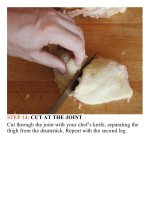The food lab better home cooking through science ( PDFDrive ) 476
Bạn đang xem bản rút gọn của tài liệu. Xem và tải ngay bản đầy đủ của tài liệu tại đây (107.71 KB, 2 trang )
So, if none of these three methods is perfect on its
own, why settle for just one? For steaks and chops,
by combining pan-searing and torching into one
hybrid technique, you can avoid all the
disadvantagesofeitheronealone.
I started by first searing one side of a steak in
smoking-hot oil and butter (the browned butter
solidshelpkickstartbrowningreactions).Assoonas
the browning started, I flipped the steak over and
immediately started cooking that top surface with
thefullblastofapropanetorch.Thelayerofoiland
butterclingingtoitssurfacehelpedtodistributethe
heat of the flame evenly, leading to excellent, allover browning and charring and creating an
unbeatable steak house broiler–quality crust in
record time. Finally, I flipped the steak back over
andtorchedthesecondside.
What about the problem of the uncombusted
propaneleavingitstelltalearoma?Turnsouttonot
beaprobleminthiscase.Becauseoftheheatofthe
skillet and the increased convection caused by the
shifting heat of the pan, the propane gets plenty of
oxygen and heat, allowing it to fully combust,
leavingbehindnothingbutsweet,succulent,charred
beef.
SOUS-VIDEANDRESTING
W
e all know that it’s important to rest your
meat before serving. It gives time for the juices
inside to settle and thicken slightly, preventing them
from leaking out excessively when you cut into the
steak.
There are, as it turns out, some downsides to
resting: Namely, your steak will have a more
significant, crusty, snappy, sizzling crust when it’s
freshofftheburnerthanafterit’srested.Thismore
appetizing crust will subsequently lead to greater
production of saliva, which in turn will lead to a
juicier sensation in your mouth when you chew the
steak—or so the theory goes. There is something









